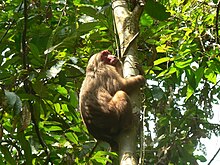Stump-tailed macaque
| Stump-tailed macaque | |
|---|---|

| |
| Scientific classification | |
| Domain: | Eukaryota |
| Kingdom: | Animalia |
| Phylum: | Chordata |
| Class: | Mammalia |
| Order: | Primates |
| Suborder: | Haplorhini |
| Infraorder: | Simiiformes |
| Family: | Cercopithecidae |
| Genus: | Macaca |
| Species: | M. arctoides[1]
|
| Binomial name | |
| Macaca arctoides[1] (I. Geoffroy, 1831)
| |

| |
| Stump-tailed macaque range (blue – native, red – introduced, orange – possibly extinct) | |
| Synonyms[2] | |
| |
The stump-tailed macaque (Macaca arctoides), also called the bear macaque, is a species of macaque native to South Asia and Southeast Asia. In India, it occurs south of the Brahmaputra River, in the northeastern part of the country.[3] Its range in India extends from Assam and Meghalaya to eastern Arunachal Pradesh, Nagaland, Manipur, Mizoram and Tripura.[4]
It is primarily frugivorous, but eats many types of vegetation, such as seeds, leaves and roots, but also hunts freshwater crabs, frogs, bird eggs and insects.[5]
Characteristics
The stump-tailed macaque has long, thick, dark brown fur covering its body, but its face and its short tail, which measures between 32 and 69 mm (1.3 and 2.7 in), are hairless.
Distribution and habitat
This
A study population was introduced to
Behaviour and ecology
Stump-tailed macaque generally share the same social structure of any macaque species with a linear dominance hierarchy that is rigid and hereditary in females yet fluctuates among males based on their fighting ability and social maneuvering, but what makes stump-tail macaques truly unique is their ability to defuse intense confrontations and maintain a high degree of pacifism and harmony in their troop, thanks to their surprisingly rich repertoire of reconciliation tactics.[9] This species has no lasting pair bonds and is truly promiscuous, a staple for macaques. Physical violence very rarely occurs, and although minor scraps often flair up and physical intimidation displays occur, they tend to quickly be resolved, resulting in this species being labelled as peaceful.[citation needed] Stump-tailed macaques are remarkably unfussy in their eating habits though fruit generally is a staple part of their diet. Stump-tail macaques have a large, bulky, muscular build with thick, solid limbs, making them very mobile on land yet quite ungainly in trees, and this unusual physique for a macaque may be responsible for this species unique tendency to consume larger quantities of meat than other macaque species. Stump-tail macaques feed on very large quantities of insects, small animals and eggs.[citation needed]
Reproduction
A study population of female stump-tailed macaques was found to have increased levels of steroid sex hormones, specifically 17β-estradiol and progesterone levels. 17β-estradiol levels were significantly greater during summer and fall and progesterone levels were significantly greater during summer, fall and winter. This explains how stump-tailed macaques have two mating seasons per year: one in summer (July–August) and one in fall (November). This is supported by the distribution of birth frequency in stump-tailed macaques.[10]
See also
- Britches – an infant stump-tailed macaque used in sight-deprivation experiments, which was stolen from the laboratory by the Animal Liberation Front.
- List of endangered and protected species of China
References
- ^ OCLC 62265494.
- ^ . Retrieved 19 November 2021.
- S2CID 86707943.
- ^ Choudhury, A.U. (2002). "Status and conservation of the stump-tailed macaque Macaca arctoides in India". Primate Report. 63: 63–72.
- ^ a b c d e f g h i j k l m n Cawthon Lang, K.A. (2005). "Primate Factsheets: Stump-tailed macaque (Macaca arctoides) Taxonomy, Morphology, & Ecology". Retrieved 2008-04-17.
- ^ Felix, Dr. Jiri. "Animals of Asia". London: Hamlyn Publishing Group, 1983.
- S2CID 245405123.
- S2CID 229677607.
- S2CID 28385684.
- PMID 29227912.

